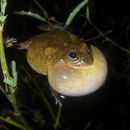en
names in breadcrumbs


Pleurodema is a genus of leptodactylid frogs from South America. They are sometimes known under the common name four-eyed frogs,[1] although this name can also refer to a particular species, Pleurodema bibroni.[2] The common name is a reference to two inguinal poison glands that resemble eyes.[3] When threatened, the frog lowers its head and raises its rear. When the frog adopts this posture, the poison glands are also raised toward the predator. The predator may also confuse the frog's raised posterior for the head of a larger animal.[4]
The genus contains only the following 15 species:[1]
Pleurodema is a genus of leptodactylid frogs from South America. They are sometimes known under the common name four-eyed frogs, although this name can also refer to a particular species, Pleurodema bibroni. The common name is a reference to two inguinal poison glands that resemble eyes. When threatened, the frog lowers its head and raises its rear. When the frog adopts this posture, the poison glands are also raised toward the predator. The predator may also confuse the frog's raised posterior for the head of a larger animal.